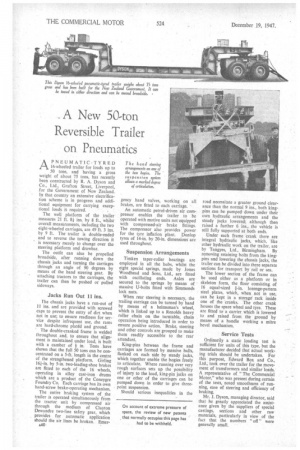_ A New 50-ton Reversible Trailer on Pneumatics
Page 50

If you've noticed an error in this article please click here to report it so we can fix it.
PNEUMAT1C-TYRED 16-wheeled trailer for loads up to
50 tons, and having a gross weight of about 75 tons, has recently been constructed by R. A. Dyson and Co., Ltd., Grafton Street, Liverpool, for the Government of New Zealand. In that country an extensive electrification scheme is in progress and additional equipment for carrying exceptional loads is required.
The well platform of the trailer measures 21 ft. 81 ins. by 8 ft., whilst overall measurements, including the two eight-wheeled carriages, are 49 ft. 3 ins. by 9 ft. The trailer is double-ended. and to reverse the towing direction it is necessary merely to change over the steering platform and drawbar.
The outfit can also be propelled broadside, after running down the chassis jacks and turning the carriages through an angle of 90 degrees by means of the hand steering gear. By attaching tractors to the carriages, the trailer can then be pushed or pulled sideways.
Jacks Run Out 11 ins.
The chassis jacks have a run-out of 11 ins, and are provided with screwed caps to prevent the entry of dirt when not in use; to ensure readiness for service despite infrequent use, he rams are hard-chrome plated and ground. ' The double-cranked frame is welded throughout and, to ensure that alignment is maintained under load, is built with a camber of in. Tests have shown that the full 50 tons can be concentrated on a 5-ft. length in the centre of the strengthened platform. Girling 161-in. by 5-in, two-leading-shoe brakes are fitted to each of the 16 wheels, operating in allny cast-iron drums which are a product of the Coneygre Foundry Co. Each carriage has its own hand-screw brake-operating mechanism.
The entire braking system of the trailer is operated simultaneously from the tractor unit by compressed air through the medium of Clayton Dewandre two-line safety gear, which provides for automatic application should the air lines be broken. Emer a40. gency hand valves, working on all brakes, are fitted to each carriage.
An automatic petrol-driven air compressor enables the trailer to be operated with motive units not equipped with compressed-air brake fittings. The compressor also provides power for the tyre inflation plant. Dunlop tyres of 14-in. by 20-in, dimensions are used throughout.
Suspension Arrangements
Timken taper-roller bearings are employed in all the hubs, whilst the eight special springs, made by Jonas Woodhead and Sons, Ltd., are fitted with oscillating ends. Axles are secured to the springs by means of massive U-bolts fitted with Simmonds lock nuts.
When rear steering is necessary, the trailing carriage can be turned by hand by means of a helmsman's wheel, which is linked up to a Renolds heavy roller chain on the turntable, chain operation being introduced in order to ensure positive action. Brake, steering and other controls are grouped to make them readily accessible to the rear attendant.
King-pins between the frame and carriages are formed by massive balls, flanked on each side by steady jacks, which together enable the bogies freely to articulate. Where running over very rough surfaces sets up the possibility of injury to the load, king-pin jacks on one or other of the carriages can be pumped down in order to give threepoint suspension.
Should serious inequalities in the road necessitate a greater ground clearance than the normal 9 ins., both kingpins can be pumped down under their own hydraulic arrangements and the steady jacks lowered; although then raised a further 6 ins., the vehicle is still fully supported at both ends.
Under each frame crank there are integral hydraulic jacks, which, like other hydraulic work on the trailer, are by Tangyes, Ltd., Birmingham. By removing retaining bolts from the kingpins and lowering the chassis jacks, the trailer can be divided into three separate sections for transport by rail or sea.
The lower section of the frame can be used either as a platform or in skeleton form, the floor consisting of 16 equal-sized I-in, lozenge-pattern steel plates, which, when not in use, can be kept in a storage rack inside one of the cranks. The other crank houses the spare wheel and tyre. These are fitted to a carrier which is lowered to and raised from the ground by means of a handle working a mitre bevel mechanism.
Service Tests
Ordinarily a static loading test is sufficient for units of this type, but the manufacturer decided that actual working trials should be undertaken. For this purpose, Edward Box and Co., Ltd., took over the trailer for the movement of transformers and similar loads. A representative of ." The Commercial Motor," who was present during certain of the tests, noted smoothness of running, ease of steering and efficiency of braking.
Mr. J. Dyson, managing director, said that he greatly appreciated the assistance given by the suppliers of special castings, sections and other raw materials, particularly in view of the fact that the numbers " off " were generally small.












































































